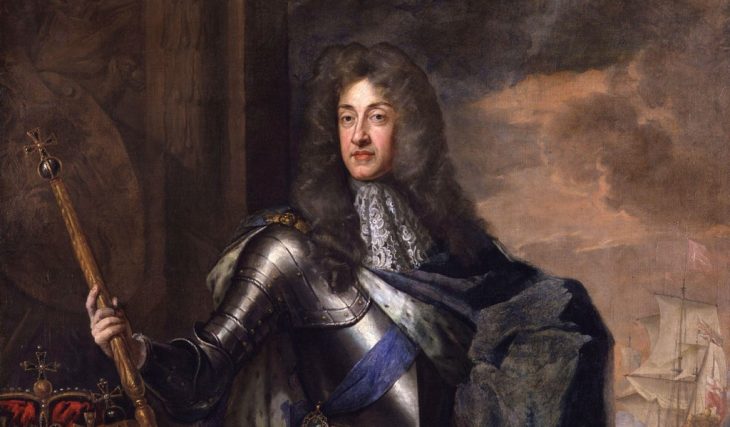
Word of the Day: Panacea
Thanks to WordGenius.com for today’s word of the day, panacea. The website gives two definitions for panacea: 1. “A mythical remedy for all illness and disease,” and 2. “A solution for all problems and difficulties.” www.etymonline.com says that the word entered the English language in the “1540s, from Latin panacea, a herb (variously identified) that would heal all illnesses, from Greek panakeia ‘cure-all,’ from panakēs ‘all-healing,’ from pan- ‘all’ (see pan-) + akos ‘cure,’ from iasthai ‘to heal’ (see -iatric). Earlier in English as panace (1510s).”
On this date in 1688, James II, King of England, Scotland, and Ireland, fled the country of his birth to live out his days in exile in France.
James was born in England, the third son of Charles I and Henrietta Maria of France. The first son, Charles James, died the day of his birth. The second son, Charles, became the king of England in 1660 and reigned until 1685. James became the king in 1685, upon the death of his older brother.
Charles and James and the other children of Charles I had fled to France in 1646 because his father was losing the Civil War against the Parliamentary forces. In 1660, Charles was named the king after the eleven-year experiment in Puritan rule had become tiresome for most of the English, and he and James returned to England.
Charles II had no legitimate children, though he did have a bunch of illegitimate ones. He was quite popular as king, and not just with the women. His nickname is The Merry King. Hilaire Belloc wrote of him, “Charles was universally beloved, beloved not only by the crowd of individuals with whom he came in contact, not only adored by his dependents, but thoroughly popular with the mass of his subjects and particularly with the poorer populace of London who knew him best” (Charles II: The Last Rally [146]). But Parliament was a bit disappointed with Charles about one thing: he did not have a legitimate heir, and thus his younger brother James was next in line for the throne.
So in 1685, when Charles II died, James II took over the throne even though he was a Roman Catholic in a decidedly Protestant country. James had converted to the Roman Catholic Church in the late 1660s, probably influenced by his mother’s faith and his years of living in France. He continued to attend Anglican services for several years, but he was not secretive about his conversion. Parliament during his reign was, for the most part, royalist and Anglican, and many thought that James shared their views despite his Catholicism.
James had two wives. The first, Anne Hyde, had met James in the Netherlands before the Restoration, and their son was actually illegitimate, but he died very young. Their second child was Mary, and at the request or insistence of King Charles, she was raised as a Protestant. Anne Hyde died in 1671, and in 1673, James married Maria Beatrice Anna Margherita Isabella d’Este, from the Italian Duchy of Modena, a devout Roman Catholic woman. Then, she had sons, and the people of England began to fear that a Roman Catholic dynasty was upon them.
The divide between James and the people of England was intensified by the results of a couple of rebellions against him, rebellions which he put down in a fairly brutal manner. Then in 1688, seven leading English lords sent a letter to William of Orange, the husband of Mary, inviting him to become the next king of England. William responded by putting together an army and crossing the channel.
According to Britannica, “In the subsequent “campaign,” James’s Protestant officers deserted to the enemy in such large numbers that he dared not commit the army to a pitched battle. This, together with the defection of his daughter Anne, finally shattered his nerve. He attempted to flee to France but was intercepted in Kent; 12 days later, on December 23, he was allowed to escape” (https://www.britannica.com/biography/James-II-king-of-England-Scotland-and-Ireland). The next year, Parliament declared that James had abdicated the throne by fleeing, and William and Mary were made king and queen of England.
The revolution of 1688 is variously called the Glorious Revolution and the Bloodless Revolution because it was accomplished without any fatal battles. It is, therefore, rare in human history. Most revolutions have involved violence, often extreme violence, especially the two great revolutions of the modern period—the French Revolution and the Russian Revolution. And the threat of violence was certainly present before all those Protestant officers abandoned James. But ultimately, there was no violence because violence is not the panacea that some people think it is. And that is a lesson we have been gradually, very gradually, learning through the millennia. Maybe someday we’ll have it figured out.
The image is of King James II, a portrait painted by Sir Godfrey Kneller (https://catholicherald.co.uk/commentandblogs/2019/03/05/the-forgotten-canonisation-cause-of-king-james-ii/).